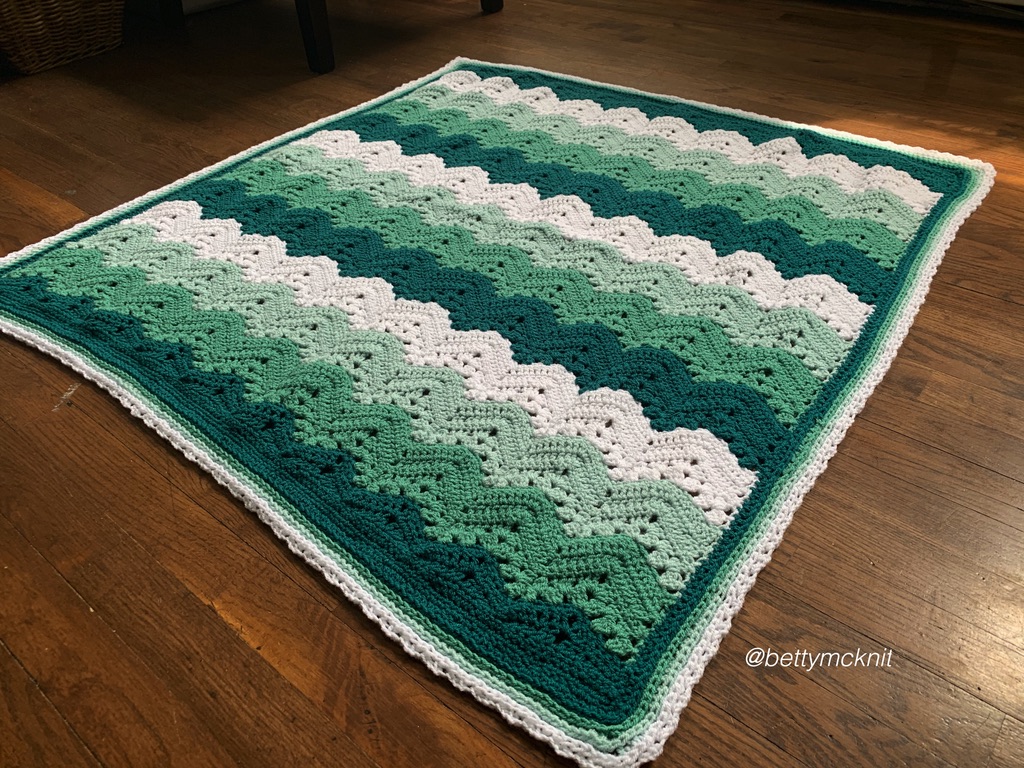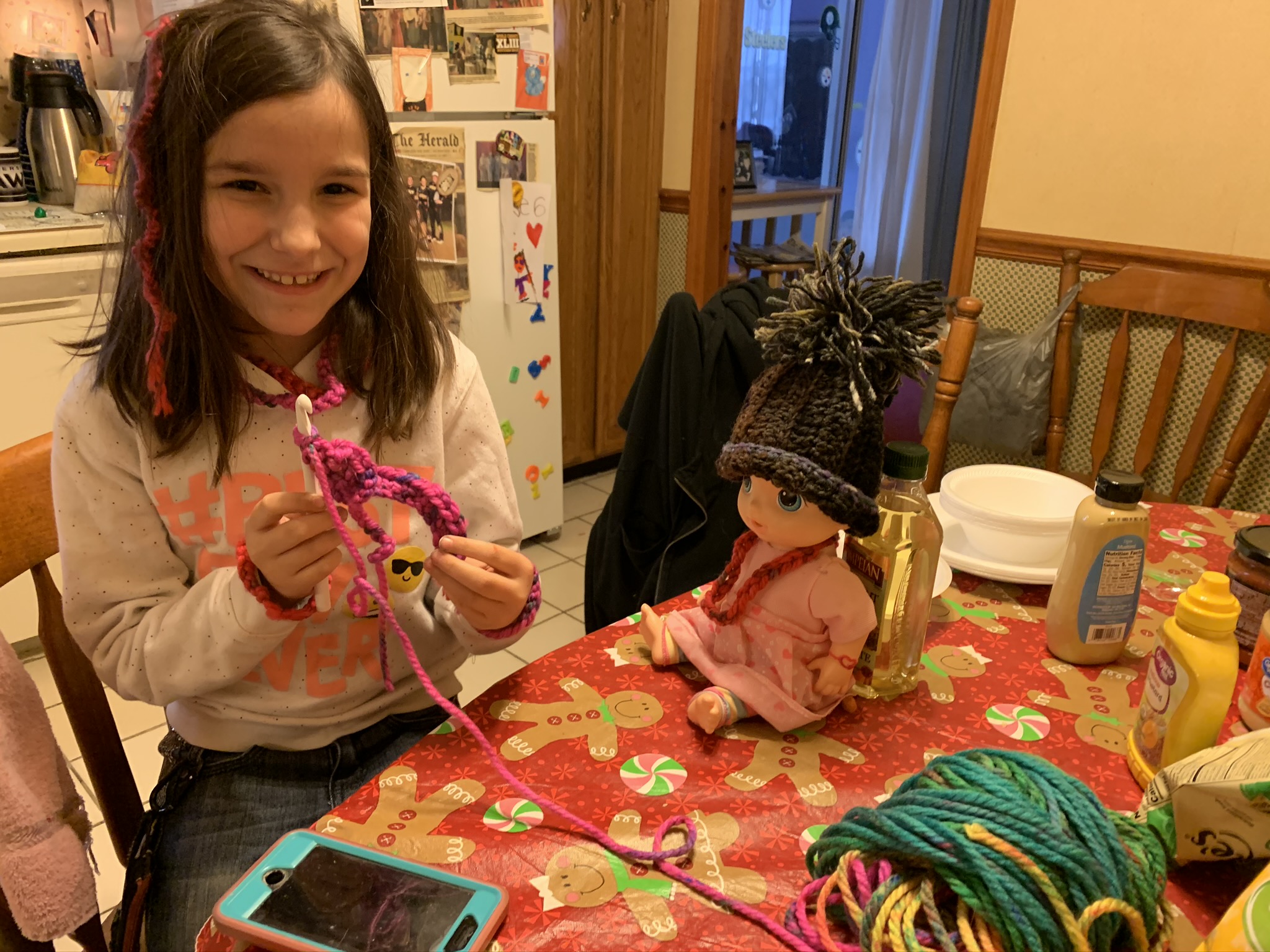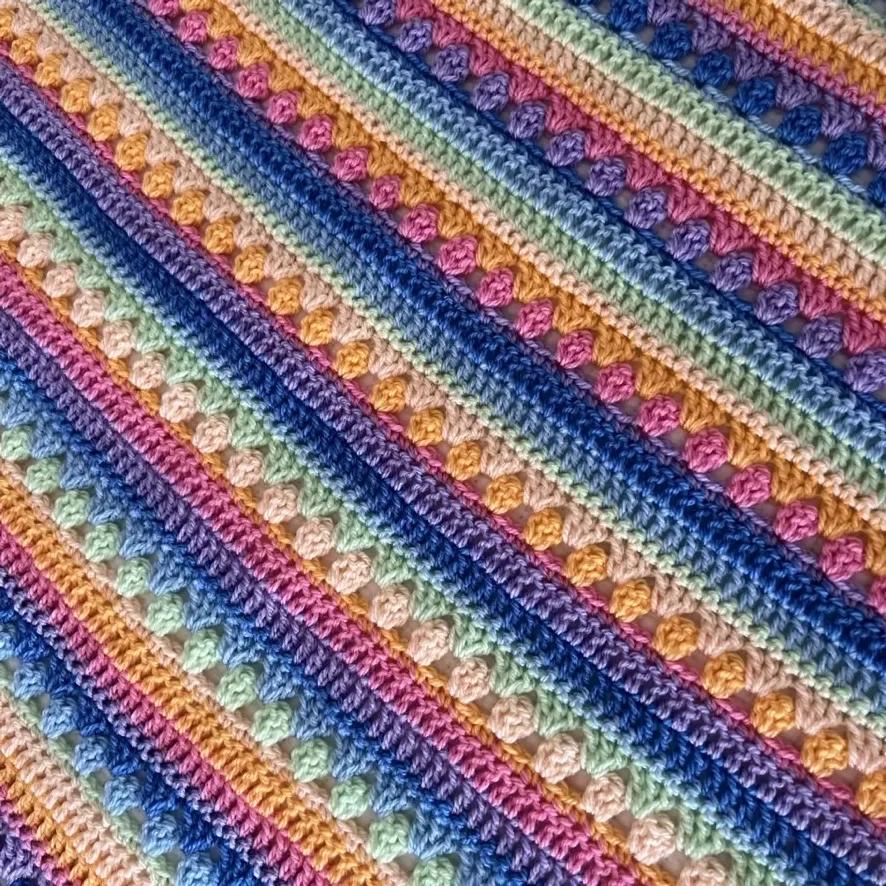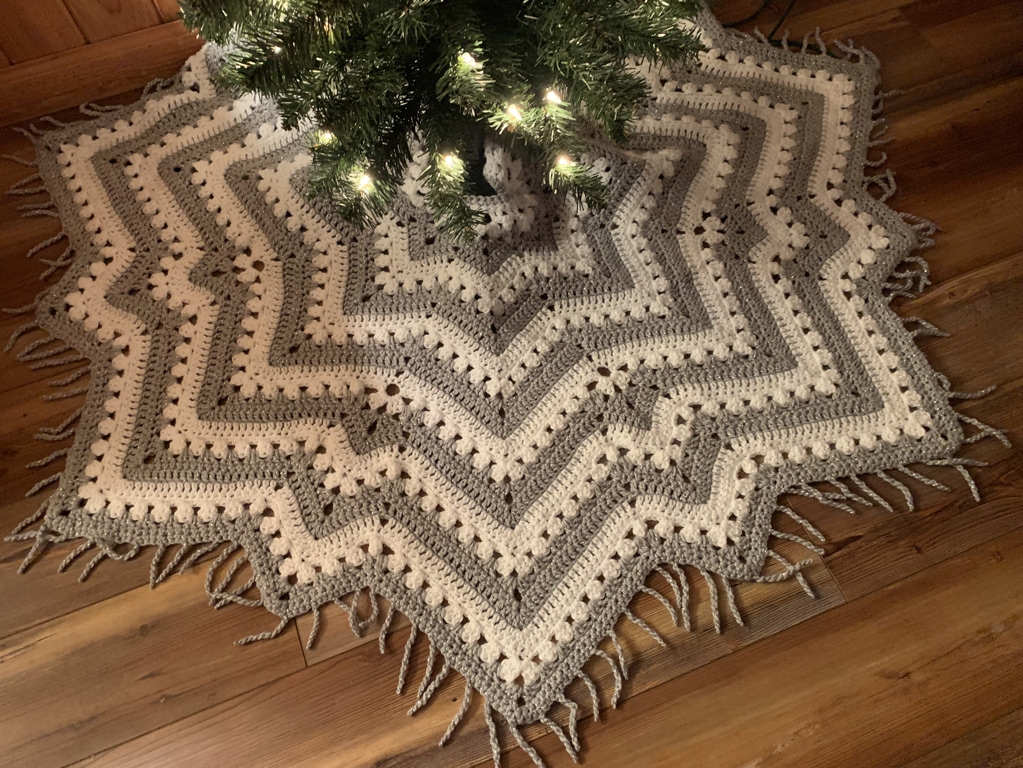6-Day Viral Blanket
6-Day Viral Blanket
A variation of the classic crochet pattern the
6-Day Kid Blanket by Betty McKnit
This page contains affiliate links. If you click these links and buy something on the page they take you to, I may, at no additional cost to you, earn a commission. I only affiliate with products and companies I feel good about. Thank you for your support!
Introduction
This blanket is a variation on the classic 6-Day Kid Blanket (6DKB). It was inspired by beautiful viral photos of 6-Day Kid Blankets made by Hanan Hanaway, “Crochet Creations by Hanan”.
This pattern gives instructions for a full-size blanket made with aran weight yarn and matches Hanan’s iconic color choices.
I have also included the camel stitch border Hanan used – she caused quite a stir when she posted a photo of her unusual way of working all four rows at once. I’ve added my own special details – a straight start and squared off edge for a clean look, and symmetrical stripes.
What is the difference between this pattern and other 6-Day Blanket patterns?
What is the difference between this pattern and other 6-Day Blanket patterns?
This pattern is very similar to the 6-Day Viral Baby Blanket, but I had quite a few requests for this variation in an adult size blankets. There are a few differences:
Size: This pattern makes a full-size “adult” afghan. The original 6DKB was toddler sized and the Viral Baby Blanket is even smaller.
Resize: The original pattern gives resize options, this pattern only gives one size.
Yarn: This pattern uses Aran Weight yarn. The original 6DKB uses chunky weight and the viral baby blanket uses DK weight.
Stripes: The original 6DKB is striped in the “Vivid Chevrons;” this pattern and the viral baby blanket uses“Viral Stripes”.
Edge: The original pattern had no edge or border. This pattern starts and ends with a straight edge, and has a border similar to the Viral Baby Blanket of four rows of camel stitch. This pattern has shells one the last round, and the baby blanket has picots.
Does it really only take 6 Days to make?
The original Classic 6-Day Kid Blanket was written for a toddler-sized blanket made with chunky weight yarn, and can easily be made in six days working an hour or two each day. This variation on the 6DKB uses the very same stitches as the original, but uses a different weight of yarn and is much bigger. It is possible to make it in six days if you have more than 2 hours per day to crochet. I think the average crocheter can complete it in about two weeks working an hour or two per day.
See my article, “Why is it called the 6-Day Kid Blanket” for more information.
First timers
If this is your first time making a 6-Day Kid Blanket, before you begin, I suggest you make a swatch on 30 chains while following along with my video tutorials on my YouTube Channel. I know you probably never swatch and will be tempted to bypass this advice, but take my word for it. The first few rows are a little tricky and you’ll sidestep common mistakes and avoid the frustration of frogging hours of hard work by swatching along with my tutorials before starting your blanket.
How to Resize
If you would like make this blanket in a different size, please see the resize chart at the end of this pattern and my 6DKB Resize Video. Note that the width of your swatch will be the same whether you use the straight start or not.

Stripe Symmetry
If you choose to alter this pattern and use more than four colors, you will need to plan ahead to make your stripes symmetrical.
No two 6-Day Blankets are alike. The 6DKB can take on many different looks depending on which rows the color changes fall on. This is the easiest of the striping variations, we call it the Viral Stripes (or Half Snowflake). It is easiest because the color changes align with the pattern repeats, but this creates a problem. For the top and bottom edges to match in shape, an additional 1/2 repeat is needed. That extra 1/2 repeat will make your stripes uneven if you don’t plan ahead.
I’ve solved this problem for you with the top-off rows, but you will need to plan your stripes. Make sure that your set-up, top-off, and first round of your border are all worked in the same color, and plan your stripe sequence so that the same color starts and ends your blanket. Watch my swatch-along video for more explanation.
Side Edges
Some crocheters have had issues with the side edges of their blankets curling. Here are some steps you can take to help alleviate this:
ch 4 at the beginning of the row where the instructions say to ch 3. This is something you should try in your swatch, as some crocheters with tighter tension find that they really do need that extra stitch. Others do fine without it.
Replace the dc at the end of each row with extended double crochet (edc)
Keep in mind when adding additional stitches on the edge you may need to skip stitches when working along the sides to get your edges to lie flat. There is no exact formula for how many sc to work into the edge. Use your judgement and lay it down often and check it as you are working.
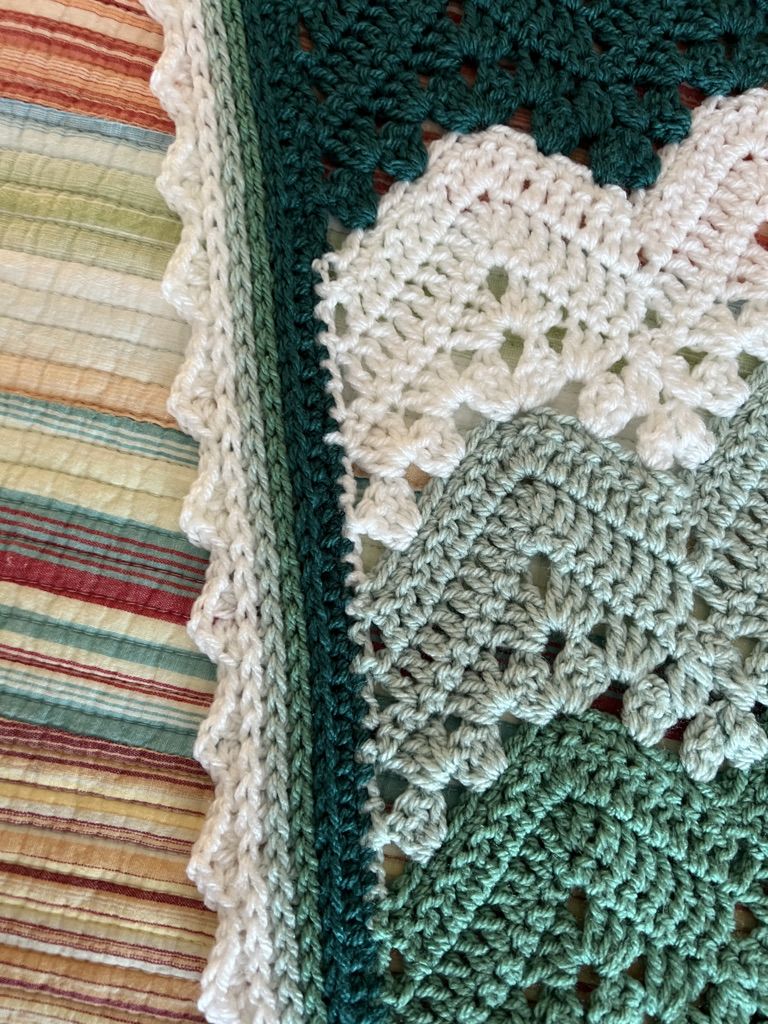
When working the last stitch of the row, insert the hook from back to front, instead of from front to back.
Work the edge into the turning chains and sc/dc stitches on the sides of the work as described at the end of this pattern, rather than working into the holes/ spaces.
Wash your blanket once it is complete, and lay it out flat to dry, gently stretching and shaping the edges.
Changing Colors
To change yarn on color changes, draw the new color through the last two loops of the last stitch of the row before the color change.
About the row numbers
In order to provide consistency across all of the 6-Day Kid Blanket pattern variations, I’ve numbered the rows to correspond to the original pattern. The cluster rows are always Row or Round 2 and 3, the dc rows are always Row or Round 5 and 6, and the sc rows are always Row or Round 4 and 7. This makes it easy to adapt the many variations of the 6-Day Kid Blanket.
You will be guided to work the rows in the proper order; don’t let the numbers throw you off or overthink a change in the sequence. Trust the pattern and if you need help find my Facebook group or Membership Community.
Details
US Terminology
Finished Size: 50” x 60”
Gauge: 18 stitches, 24 rows to 4″
Skill Level: Easy
Yarn: 3219m/3520 yards total Aran or Worsted, 805m/880 yards of each of four colors
Shown in: Stylecraft Special Aran, Color A: Teal, Color B: Sage, Color C: Duck Egg, Color D: White (four balls of each)
Colorway Inspired by Hanan Hanaway, “Crochet Creations by Hanan”
Some other suggested yarns:
Lion Brand Woolease in Rainforest, Stillwater, Succulent, and Icicle
Premiere Non Pilling Worsted in Deep Teal, Porcelain Blue, Spa, and Snow White
Hobby Lobby I Love This Yarn in Antique Teal, Ocean, Menthe, and White
Big Twist Value Worsted in Dark Teal, Sage, Aqua, and White
Hook: Furls Odyssey I (5.5 mm) and J (6 mm) hook
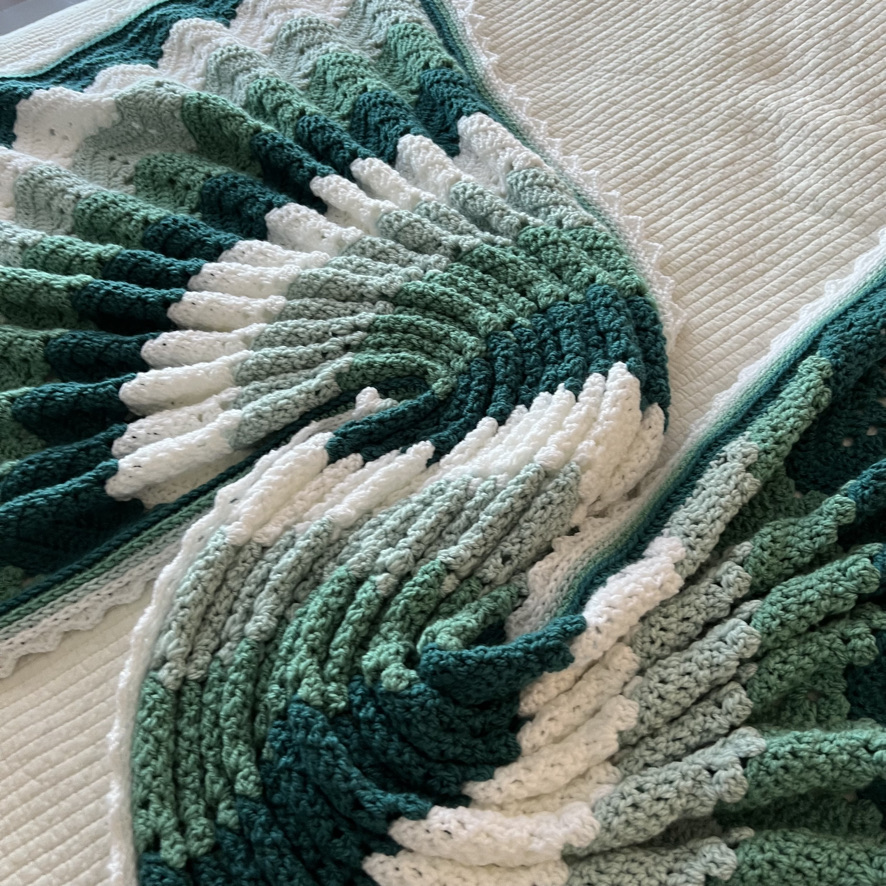
Abbreviations
camel st: camel stitch, hdc in third loop
ch: chain
dc: double crochet
dc3tog: (NOT TO BE CONFUSED WITH dec dc3tog).
Work dc3tog into one stitch – not over three stitches
[yarn over, pull up a loop, pull through two loops] 3 times. Yarn over, and pull through all 4 loops on the hook. (Be sure to pull up a loop in the same stitch every time.) dc3tog complete.
rep: repeat
hdc: half double crochet
sc: single crochet
sk: skip
sp(s): space(s)

An international community of yarnful makers and friends.
- New pattern pre-releases
- Exclusive patterns never released to the public
- Have access to Betty’s ad-free .pdf library of patterns (3-4 patterns/month)
- Access to Betty’s Design Workshop
- Uplevel your knitting and crochet skills
- Enjoy regular crochet alongs, knit alongs, and classes
- Make like-minded friendships during our weekly social and educational events
- Bonus content every month
Pattern:
Starting with Color A and larger hook, ch 160 (Multiple of 13 + 4)
Switch to smaller hook.
Setup Row 1: starting in second ch from hook, sc across.
Turn

From this point forward, unless stated otherwise, start your first st in the st below the turning ch.
Setup Row 2: ch 1, 5 sc, 6 hdc, *7 sc, 6 hdc, repeat from * to last 5 sts, 5 sc.
Turn
Setup Row 3: ch 1, 3 sc, *3 hdc, 2 dc, ch 2, 2 dc, 3 hdc, sc, sl st, sc, repeat from * to last 13 sts , 3 hdc, 2 dc, ch 2, 2 dc, 3 hdc, 3 sc.
Turn
Setup Row 4: ch 1, 3 sc, *3 hdc, 2 dc, [dc, ch 1, dc] in ch 2 sp, 2 dc, 3 hdc, sc, sl st, sc, repeat from * to last 13 sts, 3 hdc, 2 dc, [dc, ch 1, dc] in ch 2 sp, 2 dc, 3 hdc, 3 sc.
Turn
Setup Row 5: ch 1, sc, sk 1, 7 sc, *3 sc in ch sp, 7 sc, sk 1, 7 sc, repeat from * to last peak, 3 sc in ch sp, 7 sc, sk 1, sc
Turn
Change to Color B and proceed to Row 2.
This page contains affiliate links. If you click these links and buy something on the page they take you to, I may, at no additional cost to you, earn a commission. I only affiliate with products and companies I feel good about. Thank you for your support!

Row 2: ch 3, sk first 3 sc (the sc on the end of the row, the one below your turning chain counts as 1)
[3dc in next sc, sk next 2 sc] twice, [3 dc, ch 3, 3 dc] into next sc
*sk next 2 sc, 3dc into next sc, sk next 2 sc, dc3tog
sk next 4 sc, dc3tog, sk next 2 sc, 3 dc in next sc, sk next 2 sc
[ 3 dc, ch3, 3 dc] into next sc; rep from * to last 9 sc
sk next 2 sc [3 dc into next sc, sk next 2 sc] twice, 1 dc into last sc.
Turn
Row 3: ch 3, sk sp between turning ch and next 3-dc group, 3 dc into each of next 2 sp
[3dc, ch3, 3dc] into next ch-3 sp
*3 dc into next sp, dc3tog into next sp
sk next sp, dc3tog into next sp, 3 dc into next sp, [3dc, ch3, 3dc] into next ch- 3 sp
rep from * to last 3 sps, 3 dc into each of next 2 sps
1 dc into sp between last 3 dc group and turning ch.
Turn
Row 4: ch 1, sc into first dc of the row (the one right below your turning chain)
sk next dc, 1 sc into each of next 8 dc
*3 sc into next ch 3 sp, 1 sc into each of next 14 sts
repeat from * to last ch-3 sp, 3 sc into last ch-3 sp
1 sc into each of next 8 dc, sk next dc, 1 sc into top of turning ch.
Turn
Row 5: Ch 3, sk first 2 sc of the row below (the sc your turning chain is coming out of counts as the first one). 1 dc into each of next 8 sc
*3 dc into next sc (you should be working these into the center stitch of the 3 sc. If not, you may have skipped incorrectly in the beginning of the row.) 1 dc into each of next 7 sc
sk next 2 sc, 1 dc into each of next 7 sc
rep from * to last 11 sc, 3 dc into next sc, 1 dc into each of next 8 sc
sk next 2 sc, 1 dc into last st.
Turn
Row 6: Ch 3, sk first 2 dc in the row below (the dc below your turning chain counts as 1)
1 dc into each of next 8 dc
*3 dc into next dc (you should be working into center stitch of 3 dc)
1 dc into each of next 7 dc, sk next 2 dc, 1 dc into each of next 7 dc
rep from * to last 10 dc
3 dc into next dc, 1 dc into each of next 8 dc, sk last dc, 1 dc into top of turning ch.
Turn.
Row 7: Ch 1, sc into first dc (the same one the turning chain is coming out of), sk 1 dc
1 sc into each dc along row to last dc
sk last dc, 1 sc into top of turning ch.
Turn.
Change to Color C
Repeat rows 2-7 with each color [C, D, A and B] four times, then C and D.
Continue to Top Edge
Top Edge
With Color A, work Row 2 and 4 (skipping row 3). Do not fasten off. Continue Top Edge Rows 1-4 and Border Round 1 with Color A.
Top Edge Row 1: Continuing color A from row 4, ch 3. Counting the stitch under the turning chain, sk 2, 4 dc, 3 hdc, sc, sl st, sc, *3 hdc, 3 dc, sk 2, 3 dc, 3 hdc, sc, sl st, sc, repeat from * to last 9 sts, 3 hdc, 4 dc, sk 1, dc in last sc.
Turn
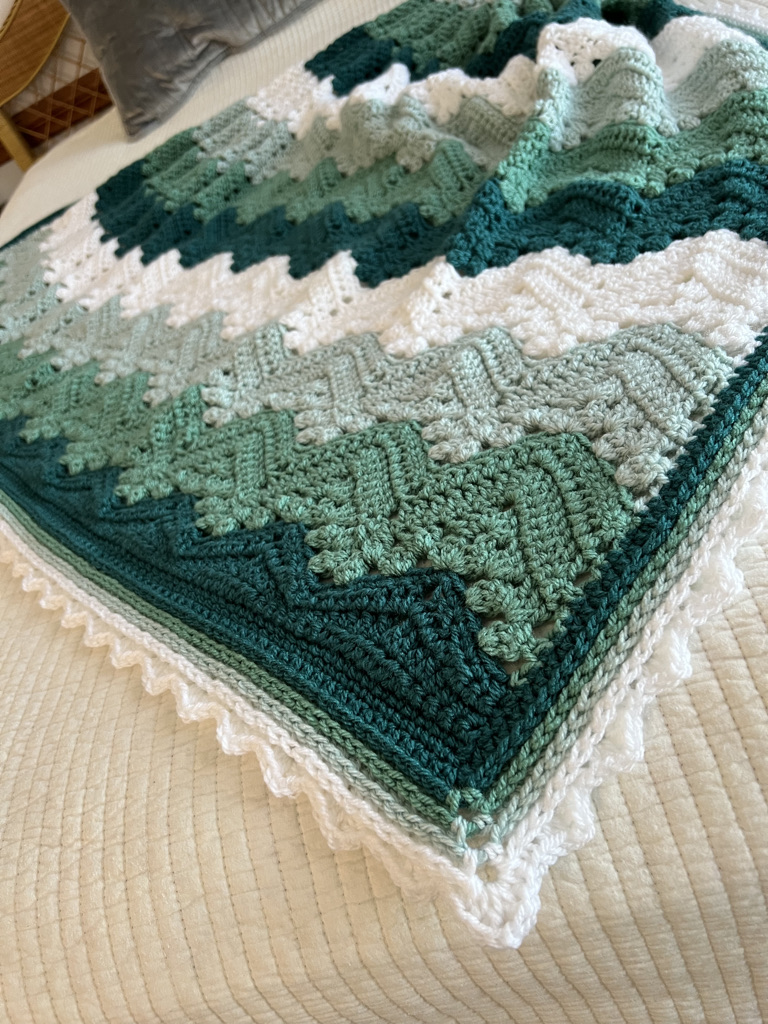
Top Edge Row 2: Ch 3, counting the stitch under the turning chain, sk 2, 3 dc, 3 hdc, sc, sl st, sc, *3 hdc, 2 dc, sk 2, 2 dc, 3 hdc, sc, sl st, sc, repeat from * to last 8 sr, 3 hdc, 3 dc, sk 1, dc in turning ch.
Turn
Top Edge Row 3: Ch 3, counting the stitch below the turning chain, sk 2, 3 hdc, 7 sc, *6 hdc, 7 sc repeat from * until 5 st remain, 3 hdc, sk 1, hdc in turning ch.
Turn
Top Edge Row 4: Ch 1, sc across to last sc, 3 sc in last stitch of the row. Do not fasten off.
Border
Border Set-Up
Continuing with same color, sc down the left side of the blanket. Treating the turning chains and the sc and dc stitches like foundation chains, work sc under 2 threads of each stitch and leave one thread below. This creates a beautiful even edge to the work. The number of sc you will put in each stitch will vary depending on your tension. Lay your work down often to check that your edge is laying flat and adjust the number of stitches accordingly. This is especially important if you followed the tips for curling edges above, in which case you may need to skip stitches and adjust your counts.
Work 3 sc into each corner of the blanket and continue across the bottom and right side of the blanket. Finish with 2 sc in the same sp as the first sc of top edge row 4, join with sl st. Do not fasten off or turn.
Border Round 1 (Continuing Color A)
Ch 2. hdc in each st around, working [hdc, ch 2, hdc] in each corner. Join w sl st to first st of the round. Fasten off.
Border Rounds 2 – 4
Join Color B to the third loop in any side st, ch 2. Work camel st across and [hdc, ch 2, hdc] in each corner ch sp. Join with sl st to first st in the round. Fasten off.
Repeat Border Round 2 with with Color C and D. Fasten off after each color and join each new color near a different corner each time to make joins less obvious. Do not fasten off after last round of Color D.
Final Border Round:
With Color D, ch 1, sc in same st. *sk 1, [2 hdc, ch 1, 2 hdc] in next st, sk 1, sc in next st. Repeat from * around, working [2 hdc, dc, ch 2, dc, 2 hdc] in each corner sp. Adjust the number of stitches skipped so that you land on corners of the blanket to work the corners. Join with sl st to first st.
Fasten off. Weave in all ends.

Beth McKee Elliott
aka Betty McKnit
Beth McKee Elliott, also known as Betty McKnit, is a crochet and knitting designer, instructor, community leader, and Master Somatic Movement Therapist and Educator. Her signature style, 6-Day Crochet, is showcased in the viral crochet patterns the 6-Day Kid Blanket and 6-Day Star Blanket.
She specializes in Somatic Crochet and Knitting, a mindfulness practice that combines crochet/knitting with body awareness techniques to prevent injury and promote well-being and creativity in crafting.
In addition to being a crochet designer, Beth is a choreographer. She is the creator and director of Small Plates Choreography Festival, Haven Movement Company, and the Dance Maker Podcast.
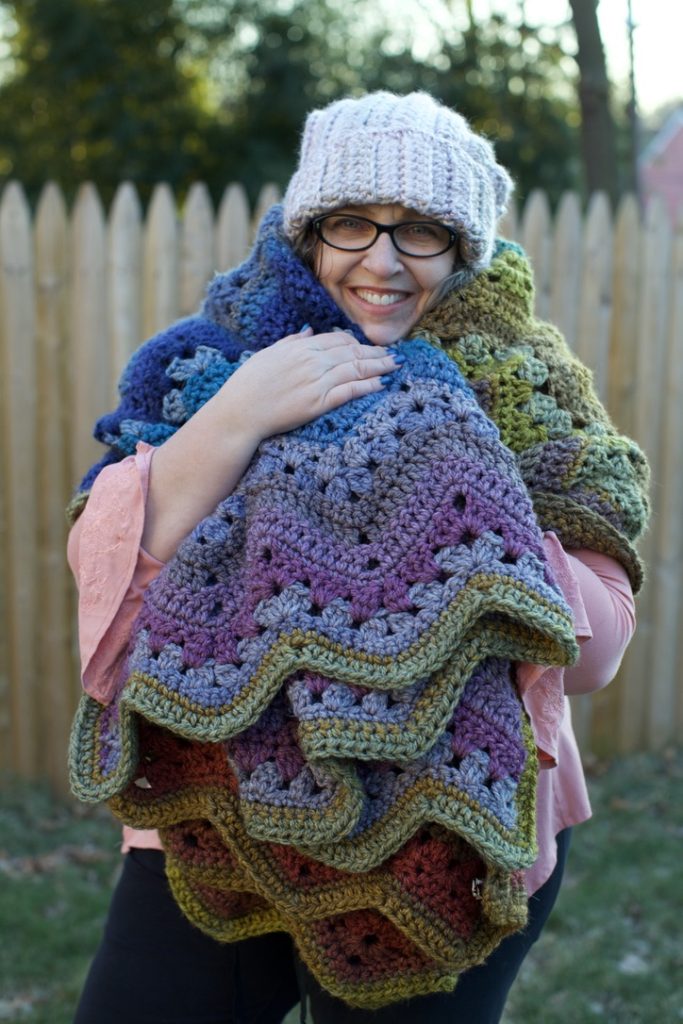
Join us in the 6-Day Kid Blanket Facebook Group for help with this pattern and to show off your finished creations. Be sure to tag @bettymcknit in your social media posts
Video tutorials available on my YouTube Channel.
This pattern contains affiliate links. If you click these links and buy something on the page they take you to, I may, at no additional cost to you, earn a commission. I only affiliate with products and companies I feel good about. Thank you for your support!
This pattern is 100% original and the intellectual property of Betty McKnit/Beth Elliott. This pattern, The 6-Day Kid Blanket, “6DKB” and derivative works are also protected by copyright. Publishing translations, corrections, variations, or tutorials of this pattern, online or elsewhere without written permission from the owner is a violation of copyright.
The stitch pattern is “Vivid Chevrons” #110 from 200 Ripple Stitch Patterns by Jan Eaton.Reprinted with permission from Quarto Publishing.

